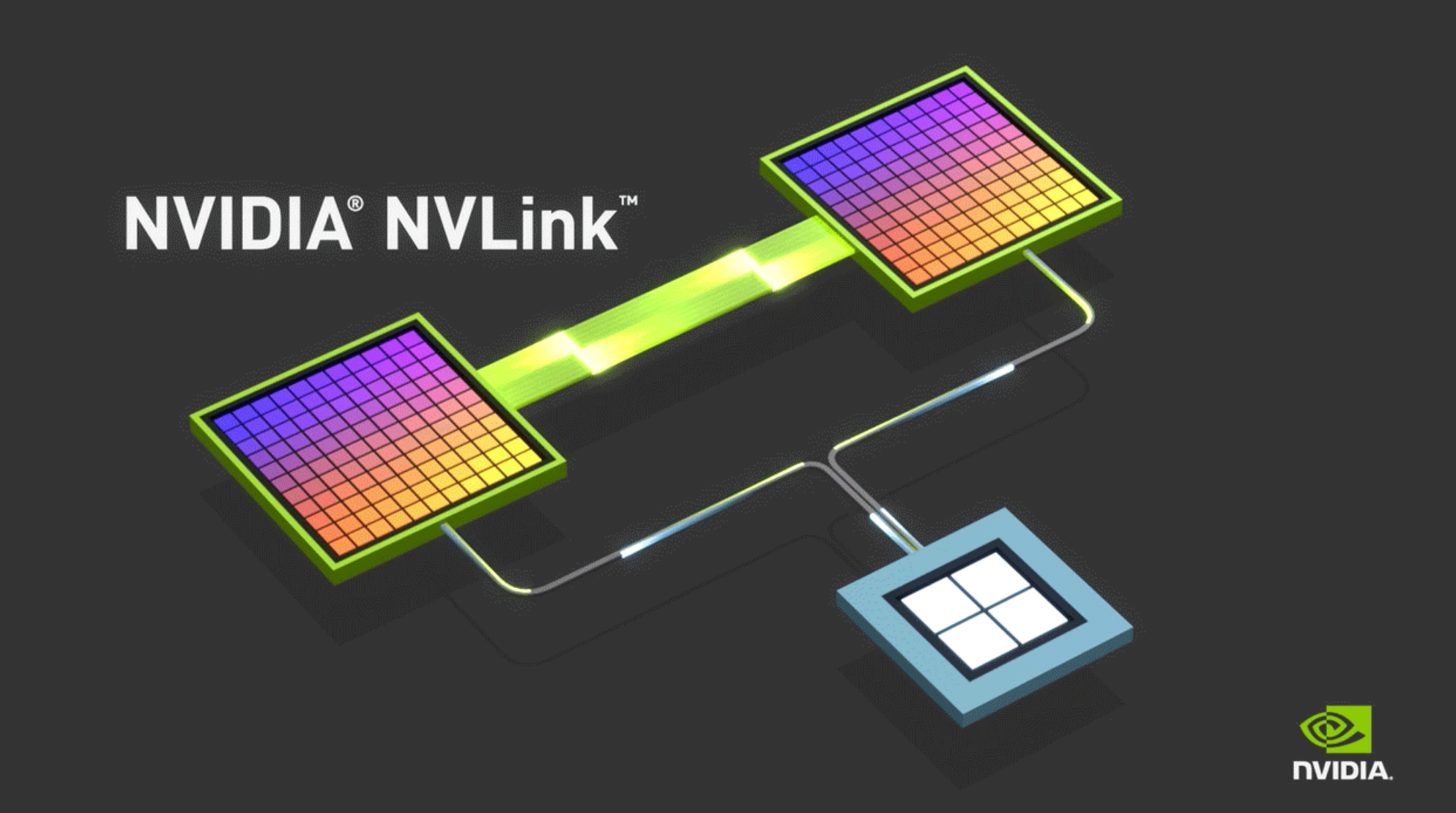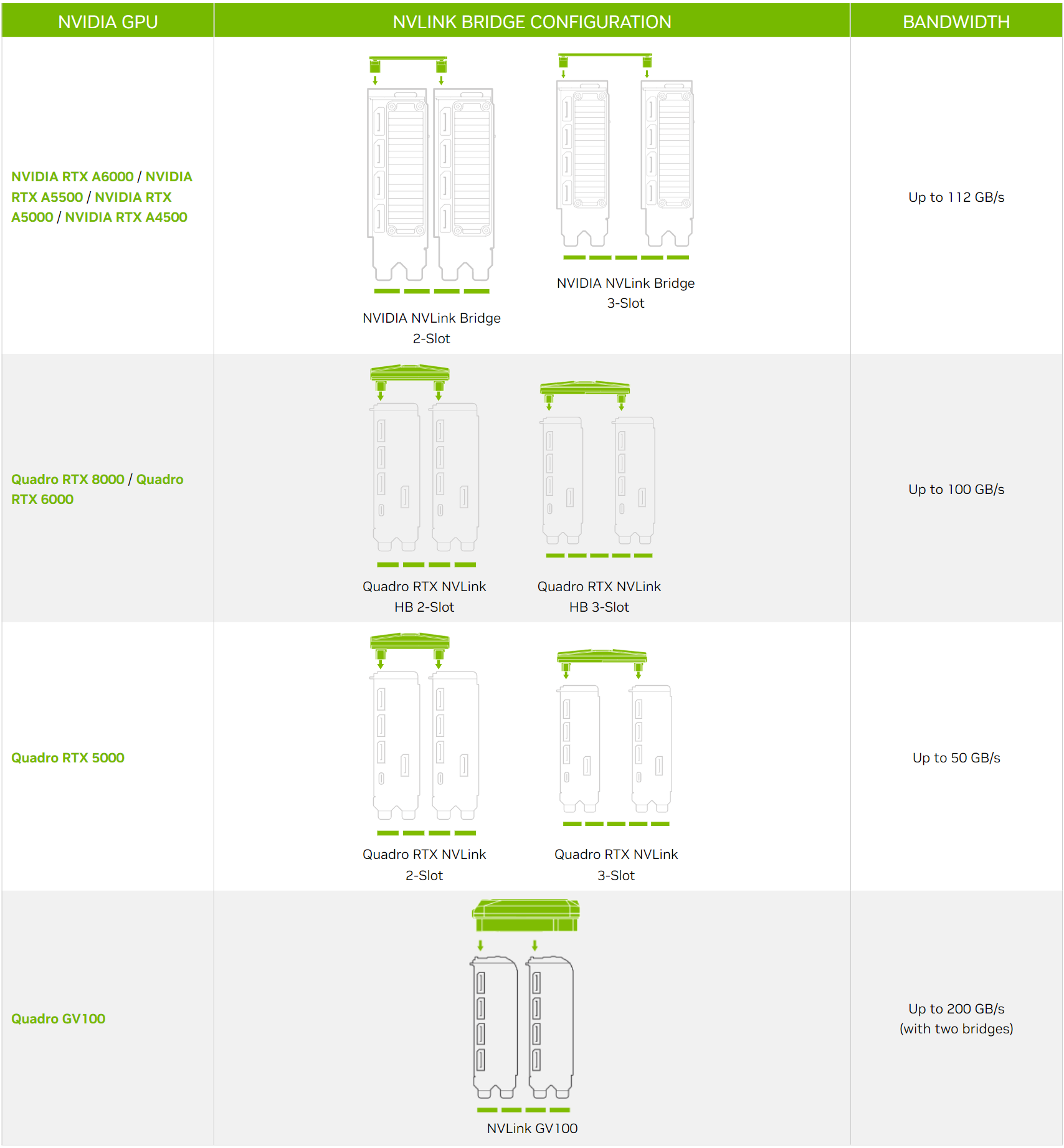
updated on 10/6/2022
What is NVLink and How Does it Work?
Supercomputers and AI systems have relied on PCI Express (PCIe 4.0, for example) in the past to connect GPUs to CPUs, but this technology has not kept up with the rapid advancements of GPUs. So, NVIDIA brought out NVLink to connect GPUs, making data exchange 5 to 12 times faster, while also being more energy efficient!
NVLink Explained
NVLink is is the world's first proprietary system interconnect technology from NVIDIA that allows multiple GPUs to communicate directly via a high-speed interconnection, giving NVLink a big advantage by allowing the available memory of both GPUs to be combined and accessible at all times.
This increases the speed at which data can be exchanged, allowing for applications and workloads designed with NVIDIA® NVLink™ in mind to benefit from significant performance increases.
NVLink requires a physical bridge between the cards and uses mesh networking, which is a local network topology in which the infrastructure nodes connect directly in a non-hierarchical way, enabling each node to relay information instead of routing it through any single node.

As to which models of the NVLink bridge work best with which GPUs: GV100, GP100, Quadro RTX, Titan RTX, GeForce RTX 20-series, GeForce RTX 30-series, Professional Ampere RTX, and NVIDIA Data Center GPUs all support NVLink. NVLink bridges are also available in various sizes for both Quadro and GeForce, RTX, and Data Center GPU lines.
The A100 and H100 PCIe counterparts can be connected with up to 3 NVLink bridges for even more bandwidth interconnect.
NVIDIA Data Center GPUs like the A100 and the H100 SXM variants are connected via a special NVLink Switch System built onto the HGX system board or DGX system with up to a total of 600GB/s (A100) or 900GB/s (H100) bandwidth.
Newer Generation NVIDIA GPUs do not carry support for NVLink including the GeForce RTX 4090 and the RTX 6000 Ada Generation GPU.
Matrix Diagram

Conclusion
NVLink bridges come in all different shapes and sizes but all serve the same function. There are Quadro RTX branded, Titan RTX branded, GeForce RTX branded, and more to match your setup aesthetic. They are available in different sizes: 2-slot and 3-slot to accommodate different size GPUs and setups.
As of October 2022, NVLink is being phased out in NVIDIA's new Ada Lovelace architecture. The GeForce RTX 4090 and the RTX 6000 Ada both do not support NVLink.
NVIDIA is reserving NVLink to be utilized in the data center where parallelization between a whole cluster or infrastructure of GPUs requires extremely quick and responsive GPU-to-GPU connectivity and bandwidth.
Still have questions? Feel free to contact us.

NVLink - From one GPU to another!
updated on 10/6/2022
What is NVLink and How Does it Work?
Supercomputers and AI systems have relied on PCI Express (PCIe 4.0, for example) in the past to connect GPUs to CPUs, but this technology has not kept up with the rapid advancements of GPUs. So, NVIDIA brought out NVLink to connect GPUs, making data exchange 5 to 12 times faster, while also being more energy efficient!
NVLink Explained
NVLink is is the world's first proprietary system interconnect technology from NVIDIA that allows multiple GPUs to communicate directly via a high-speed interconnection, giving NVLink a big advantage by allowing the available memory of both GPUs to be combined and accessible at all times.
This increases the speed at which data can be exchanged, allowing for applications and workloads designed with NVIDIA® NVLink™ in mind to benefit from significant performance increases.
NVLink requires a physical bridge between the cards and uses mesh networking, which is a local network topology in which the infrastructure nodes connect directly in a non-hierarchical way, enabling each node to relay information instead of routing it through any single node.

As to which models of the NVLink bridge work best with which GPUs: GV100, GP100, Quadro RTX, Titan RTX, GeForce RTX 20-series, GeForce RTX 30-series, Professional Ampere RTX, and NVIDIA Data Center GPUs all support NVLink. NVLink bridges are also available in various sizes for both Quadro and GeForce, RTX, and Data Center GPU lines.
The A100 and H100 PCIe counterparts can be connected with up to 3 NVLink bridges for even more bandwidth interconnect.
NVIDIA Data Center GPUs like the A100 and the H100 SXM variants are connected via a special NVLink Switch System built onto the HGX system board or DGX system with up to a total of 600GB/s (A100) or 900GB/s (H100) bandwidth.
Newer Generation NVIDIA GPUs do not carry support for NVLink including the GeForce RTX 4090 and the RTX 6000 Ada Generation GPU.
Matrix Diagram

Conclusion
NVLink bridges come in all different shapes and sizes but all serve the same function. There are Quadro RTX branded, Titan RTX branded, GeForce RTX branded, and more to match your setup aesthetic. They are available in different sizes: 2-slot and 3-slot to accommodate different size GPUs and setups.
As of October 2022, NVLink is being phased out in NVIDIA's new Ada Lovelace architecture. The GeForce RTX 4090 and the RTX 6000 Ada both do not support NVLink.
NVIDIA is reserving NVLink to be utilized in the data center where parallelization between a whole cluster or infrastructure of GPUs requires extremely quick and responsive GPU-to-GPU connectivity and bandwidth.
Still have questions? Feel free to contact us.




.jpg?format=webp)